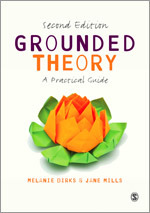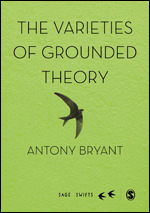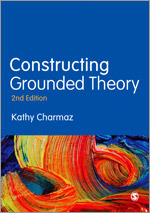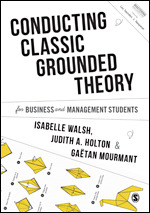Grounded Theory
In the first quarter of 2021 we explore design steps, starting with a January focus on research questions. We’ll continue to learn about the design stage in February with a focus on Choosing Methodology and Methods.
What is Grounded Theory?
Grounded theory is used by qualitative, quantitative, and mixed methods researchers who are interested in generating new theoretical constructs, principles, or models. The SAGE Handbook of Current Developments in Grounded Theory describes it this way:
According to Barney Glaser, grounded theory (GT) is a ‘search for patterns’ (Walsh et al., 2015a) and ‘the systematic generation of theory from data that has itself been systematically obtained’ (Glaser, 1978, p. 2). Glaser's contribution emerged through an approach to quantitative data that he used during his doctoral studies at Columbia University. Following the dominant research paradigm, which acknowledged solely hypothetical-deductive quantitative research at the time, the logic of research was one of confirmation and not discovery: empirical quantitative data were used to verify hypotheses; qualitative research had very bad press as it was considered by many as ‘unscientific'. Meanwhile, through the work of Paul Lazarsfeld in Columbia, whose interest was to identify unobserved variables through latent structure analysis, Glaser was initiated into elaboration analysis and ‘qualitative mathematics’ (Glaser, 1998). Thus, in his doctoral work, Glaser used quantitative data in an exploratory stance to discover unanticipated patterns (Holton & Walsh, 2016).
Glaser believed that this originally quantitative analytic approach could also be applied to qualitative data and, hence, help provide qualitative research with a more systematic approach, whose roots were found in ‘hard’ sciences. His meeting with Anselm Strauss, who was trained in Chicago School symbolic interactionism and worked with qualitative data, proved him right, allowed Glaser and Strauss to combine their methodological ideas into GT, and led to them co-authoring their famous study about the awareness of dying (Glaser & Strauss, 1965). Both were then asked to detail the methodology they used for this study, which in turn led to the seminal book about GT they co-authored in 1967. In this book, and despite its title, which highlights qualitative data, the use of both qualitative and quantitative data is proposed (a full chapter of the 1967 book is dedicated to quantitative data), even though only secondary quantitative data were considered by Glaser at the time. GT has become the dominant qualitative approach since the late 1980s in many disciplines (Bryant & Charmaz, 2007).
The original 1967 work was subsequently built upon by both Glaser (see for instance Glaser, 1978) and Strauss (see for instance Strauss & Corbin, 1990) separately, through their own diverging philosophical perspectives (postpositivism for Glaser and symbolic interactionism for Strauss), as well as by other authors through still different philosophical perspectives, such as constructivism for Charmaz (see for instance Charmaz, 2009). However, all these authors (except Glaser) mostly used qualitative data. Since GT was first described in 1967 through the epochal collaboration of Glaser and Strauss, GT has been understood by various authors as a technique, a method, a methodology, a framework, a paradigm, or as a meta-theory of inductive research design (Walsh et al., 2015a). It is only in very recent years that a renewed interest in its application with primary quantitative data and mixed qualitative and quantitative data has emerged (Walsh, 2015a, 2017; Walsh et al., 2015a, 2015b).
Whatever the philosophical perspective adopted by the researcher, and whatever the data that are used, one has to understand that the term ‘grounded theory’, and the corresponding acronym ‘GT’ that we use, refer both to a process through which a research study may be conducted and also an output, specifically a theory, a ‘grounded theory’, a theory grounded in data, which results from this process. The resulting theory, and its possible form, scope, and reach, will depend on the philosophical perspective adopted by the researcher, ranging from nomothetic (basic assumption: reality is governed by universal laws) to idiographic (basic assumption: reality is multiple, individually and socially constructed, and context-dependent), including all possible alternative philosophical positions in between these two extreme positions (Walsh et al., 2015b).
Johnson, R. & Walsh, I. (2019). Mixed grounded theory: merging grounded theory with mixed methods and multimethod research. In The SAGE Handbook of Current Developments in Grounded Theory (pp. 517-531). SAGE Publications Ltd, https://www.doi.org/10.4135/9781526485656
Open Access Articles using Grounded Theory
Birks, M., Hoare, K., & Mills, J. (2019). Grounded Theory: The FAQs. International Journal of Qualitative Methods. https://doi.org/10.1177/1609406919882535
Since being developed as a research methodology in the 1960s, grounded theory (GT) has grown in popularity. In spite of its prevalence, considerable confusion surrounds GT, particularly in respect of the essential methods that characterize this approach to research. Misinformation is evident in the literature around issues such as the various approaches to GT, how long the process takes, the role of literature and preconceptions, generating and using data and strategies to produce theory. This article examines the most frequently asked questions about GT in an effort to demystify its purpose and use. Understanding the fundamental concepts of GT is critical to the correct use and application of GT methods and the ultimate production of theory that is grounded in data. More significantly, this understanding can prevent researchers encountering common pitfalls that can impede the process and impact the products of research.
Bryant, A. (2021). Continual Permutations of Misunderstanding: The Curious Incidents of the Grounded Theory Method. Qualitative Inquiry, 27(3–4), 397–411. https://doi.org/10.1177/1077800420920663
This article draws attention to the ways in which Grounded Theory Method (GTM) continues to be a target of criticism, misunderstanding, and ill-judgement more than 50 years after its first appearance. This disparagement originates in part from some key paradoxes in the method itself. Yet this is insignificant in contrast to the continuing antagonism emanating from outside the method, indicating critical limitations in the practices of the gatekeepers of the academic world. GTM seems to be the target of continual permutations of misunderstanding, and it is these that I wish to address, and I hope, dispel in what follows.
Charmaz, K. (2017). Special Invited Paper: Continuities, Contradictions, and Critical Inquiry in Grounded Theory. International Journal of Qualitative Methods. https://doi.org/10.1177/1609406917719350
What continuities and contradictions can qualitative researchers discern among versions of the grounded theory method? How do contradictions within the method affect research practice? How do new versions of grounded theory advance research practice and critical inquiry? To answer these questions, this keynote address begins with a brief overview of grounded theory for those who are unfamiliar with the method and subsequently discusses the continuities and contradictions between versions of the method. Constructivist grounded theory (CGT) uses the methodological strategies of the original version but builds on its pragmatist heritage, shifts its epistemological foundations, and resolves contradictions in earlier versions of the method. The result means placing grounded theory in the social constructionist tradition, viewing data as co-constructed with research participants, puncturing deeply held methodological preconceptions, and subsequently fostering a heightened methodological self-consciousness. The practice of CGT assists researchers in interrogating their data, nascent analyses, research actions, and themselves each step along the way. Subsequently, researchers can gain awareness of the pervasiveness of Anglo-North American worldviews throughout inquiry. CGT not only aids theorizing and defining and developing emergent critical questions during the research process but also brings power into purview.
Chun Tie, Y., Birks, M., & Francis, K. (2019). Grounded theory research: A design framework for novice researchers. SAGE Open Medicine. https://doi.org/10.1177/2050312118822927
Abstract. Grounded theory is a well-known methodology employed in many research studies. Qualitative and quantitative data generation techniques can be used in a grounded theory study. Grounded theory sets out to discover or construct theory from data, systematically obtained and analysed using comparative analysis. While grounded theory is inherently flexible, it is a complex methodology. Thus, novice researchers strive to understand the discourse and the practical application of grounded theory concepts and processes.
Glaser, B. G. (2002). Conceptualization: On Theory and Theorizing Using Grounded Theory.International Journal of Qualitative Methods, 23–38. https://doi.org/10.1177/160940690200100203
Abstract. This article explores the use of grounded theory to generate conceptualizations of emergent social patterns in research data. The naming of patterns and their abstraction across time, place and people, are discussed. The constant comparative method employed in grounded data analysis is offered as a developmental tool for enhancing researchers' abilities to conceptualize and form emergent theories. Conceptual levels, descriptions, power and flawed approaches to analysis are explored at length.
Giske, T., & Artinian, B. (2007). A Personal Experience of Working with Classical Grounded Theory: From Beginner to Experienced Grounded Theorist. International Journal of Qualitative Methods, 67–80. https://doi.org/10.1177/160940690700600405
Abstract. In this article the authors offer an example of the application of principles of classical grounded theory (Glaser) in data collection and analysis and present how they generated a substantive grounded theory named Preparative Waiting for patients who underwent the diagnostic phase at a gastric ward. They demonstrate how patients' main concern emerged by constant comparison of data in open coding and how the core category of the theory and related concepts developed through selective coding. The authors offer examples of memos, the fitting of concepts to their data set, and the process of theoretical coding to illustrate how three different models were generated to improve fit, relevance, and workability of their grounded theory. They also discuss when and how to search and read the literature during a grounded theory study.
Knigge, L., & Cope, M. (2006). Grounded Visualization: Integrating the Analysis of Qualitative and Quantitative Data through Grounded Theory and Visualization. Environment and Planning A: Economy and Space, 38(11), 2021–2037. https://doi.org/10.1068/a37327
Abstract. Our purpose in this paper is to conceptualize and demonstrate an integrated analytical method for using both qualitative and quantitative data through geographic information systems (GIS) and ethnography. We acknowledge that the use of both types of data has been possible in GIS for some time, particularly for representation purposes. However, a recursive integration of different forms of data at the analysis level has been less explored and minimally theorized. Drawing on recent work in critical GIS and feminist perspectives, we suggest that visualization offers a strong technique for this effort but we approach it from the analytical base of grounded theory. Thus, we present an example of how grounded theory and visualization might be used together to construct an integrated analysis strategy that is both iterative and reflexive, both contextual and conceptual. We use Knigge's work on community gardens in Buffalo, New York, to provide a substantive example of the proposed methods.
Potrata, B. (2010). Rethinking the Ethical Boundaries of a Grounded Theory Approach. Research Ethics, 6(4), 154–158. https://doi.org/10.1177/174701611000600408
Abstract. Grounded theory has become an established approach in (applied) qualitative research. Researchers could have an on-going, relative freedom when using this research strategy but their creativity will have been limited by the number of participants and interviews, and by the methodology that they have declared in their research ethics committee application. Since no robust evidence exists about potential harm in qualitative research in general and grounded theory in particular, we should rethink whether a greater freedom might be allowed to researchers when using a grounded theory approach. It is concluded that a greater freedom should be allowed, but only to skilled researchers as those with less experience might use less rigid rules to cover their lack of skills and research experience, potentially burdening the study participants unnecessarily.
Ralph, N., Birks, M., & Chapman, Y. (2014). Contextual Positioning: Using Documents as Extant Data in Grounded Theory Research.SAGE Open. https://doi.org/10.1177/2158244014552425
Abstract. The use of documents as a source of extant data is relatively common in grounded theory (GT) research. While GT promotes the dictum “all is data,” finding consistent commentary on how to use documents as data is difficult, especially among seminal works. The need to be aware of the context of extant data is a vital step prior to commencing analysis, especially in view of the lack of physical interaction between the researcher and that data. Contextual positioning is proposed as a tool that can be used to prepare extant data for analysis. Contextual positioning enhances the interactivity of the data collection process and positions the researcher before the document in a more reflexive manner. A model of contextual positioning is presented in this article to assist researchers in positioning extant data (such as documents) more reflexively. A concrete example of the use of this method is outlined to promote understanding of the value of this process
Subramani, S. (2019). Practising reflexivity: Ethics, methodology and theory construction. Methodological Innovations. https://doi.org/10.1177/2059799119863276
Abstract. Reflexivity as a concept and practice is widely recognized and acknowledged in qualitative social science research. In this article, through an account of the ‘reflexive moments’ I encountered during my doctoral research, which employed critical theory perspective and constructivist grounded theory methodology, I elaborate how ethics, methodology and theory construction are intertwined. Further, I dwell on the significance of reflexivity, particularly in qualitative research analysing bioethics concepts. Through an account of the universal ethical principles that ‘I’, as a researcher, encounter, and a micro-analysis of the observed relationships that influence the theoretical construction and arguments developed, I explore the quandaries an ethics researcher undertaking a reflexive approach faces. I elucidate that reflexivity unveils – for both researcher and reader – how the researcher(s) arrive(s) at certain positions during the knowledge construction process. I conclude by stating that reflexivity demystifies the moral and epistemological stances of both the study and researcher(s).
Relevant SAGE Books

Grounded Theory A Practical Guide, Second Edition by Melanie Birks and Jane Mills (2015)

The Varieties of Grounded Theoryby Antony Bryant (2019)

Constructing Grounded Theory Second Edition by Kathy Charmaz (2014)
Doing Grounded Theory by Uwe Flick (2018)

Conducting Classic Grounded Theory for Business and Management Students by Isabelle Walsh, Judith A. Holton, Gaëtan Mourmant (2019)
Use this code, MSPACE20, for a 20% discount when you order a research methods book from SAGE Publishing.
